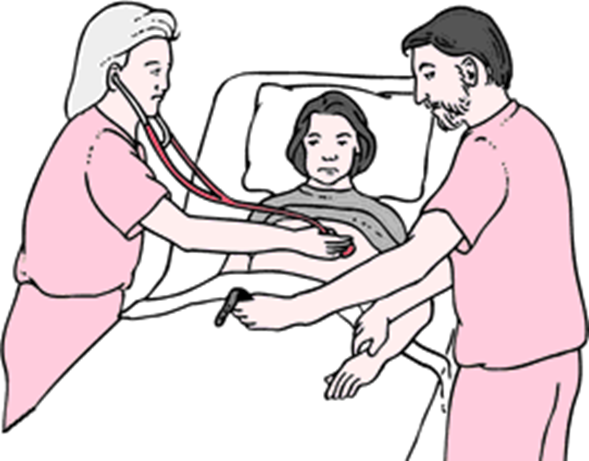A nurse is assessing a client who has a central venous catheter (CVC) with intravenous (IV) fluids infusing. The client suddenly develops shortness of breath, and the nurse notes that the IV tubing and needleless connector device are disconnected. Which of the following actions should the nurse take first?
Close the pinch clamp on the CVC.
Obtain a prescription for stat ABGS (Arterial Blood Gas Studies).
Place the client in the left Trendelenburg position.
Check the tubing for placement of a locking adaptor.
The Correct Answer is A
Choice A rationale:
The nurse's first priority in this situation should be to close the pinch clamp on the central venous catheter (CVC). This will prevent air from entering the client's vascular system and causing an air embolism, which can lead to serious complications. Once the clamp is closed, the nurse can then proceed with further assessments and interventions.
Choice B rationale:
Obtaining a prescription for stat ABGS (Arterial Blood Gas Studies) is not the first action the nurse should take in this situation. While ABGS may be relevant later to assess the client's respiratory status, the immediate concern is to prevent air embolism by closing the disconnected IV tubing.
Choice C rationale:
Placing the client in the left Trendelenburg position is not the first priority in this situation. The Trendelenburg position is used to increase venous return and is typically indicated in cases of hypotension or shock. Closing the clamp to prevent an air embolism should be the nurse's initial action.
Choice D rationale:
Checking the tubing for the placement of a locking adaptor is not the first action the nurse should take. While it is essential to ensure that the IV tubing is properly connected and secured, preventing the air from entering the CVC should take precedence in this urgent situation.
Nursing Test Bank
Naxlex Comprehensive Predictor Exams
Related Questions
Correct Answer is C
Explanation
Choice A rationale:
The nurse should not cross the client's legs when sitting in the recliner following a total left hip arthroplasty. Crossing the legs can put strain on the operative hip and may increase the risk of dislocation or other complications.
Choice B rationale:
Providing a heating pad to the operative hip is not recommended. Heat can increase blood flow to the area and may lead to increased swelling and potential complications in the postoperative period.
Choice C rationale:

Placing a pillow between the legs when turning the client to their side is the correct action. This technique is known as the "abduction pillow”. or "wedge pillow.”. It helps maintain proper hip alignment and prevents the operated leg from crossing the midline, reducing the risk of dislocation and promoting healing.
Choice D rationale:
Having the client lean forward when assisting them out of the bed is not appropriate after a total left hip arthroplasty. Leaning forward can put strain on the hip joint and increase the risk of injury.
Correct Answer is B
Explanation
Choice A rationale:
A capillary refill of less than 1 second is a normal finding and indicates adequate peripheral perfusion. It is not a cause for concern in this postoperative client.
Choice B rationale:

The presence of a pulse deficit should be reported to the provider because it suggests a discrepancy between the apical and radial pulses, indicating potential cardiovascular compromise or inadequate arterial perfusion.
Choice C rationale:
A systolic blood pressure 10 points lower than before surgery can be a normal response to anesthesia or surgery and may not necessarily require immediate reporting unless accompanied by other concerning symptoms or vital sign abnormalities.
Choice D rationale:
Pulse oximetry at 96% is within the normal range for oxygen saturation and does not warrant immediate reporting. However, if the client is experiencing respiratory distress or other concerning symptoms, it should be addressed promptly.
Whether you are a student looking to ace your exams or a practicing nurse seeking to enhance your expertise , our nursing education contents will empower you with the confidence and competence to make a difference in the lives of patients and become a respected leader in the healthcare field.
Visit Naxlex, invest in your future and unlock endless possibilities with our unparalleled nursing education contents today
Report Wrong Answer on the Current Question
Do you disagree with the answer? If yes, what is your expected answer? Explain.
Kindly be descriptive with the issue you are facing.
